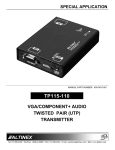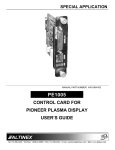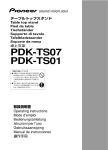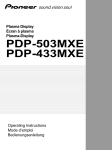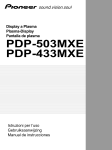Download SPECIAL REPORT - cleverdis
Transcript
SPECIAL REPORT PLASMA: EXPANDING THE POSSIBILITIES A SPECIAL REPORT ON PIONEER’S EXPANSION SOLUTION FOR PROFESSIONAL PLASMA 02 I A CLEVERDIS SPECIAL REPORT I PIONEER’S EXPANSION SOLUTION FOR PROFESSIONAL PLASMA Richard Barnes Editor in chief Expanding the Possibilities This is expensive both in terms of equipment and the requirement to build an installation that ‘hides’ the background infrastructure. Indeed, in our discussion with installers, integrators and end users, we have found that many companies ultimately seek lower cost alternatives to plasma when the true cost of building a network of screens becomes apparent. However, a truism of the IT industry is that technology always adjusts to meet demand and with customers requesting more innovative and cost efficient ways to build plasma networks, we are now seeing manufacturers adapt and respond to their market. Intelligent infrastructure Cleverdis has worked in the display market for more than seven years, and there is no doubt that in our view, the plasma sector is undergoing an exciting period of accelerated technological change. Advances in design are taking display quality to exceptional levels. Screens from companies like Pioneer provide true-XGA performance, high levels of brightness and over a billion colours for stunning images. But while a plasma screen with its sleek, attractive form adds aesthetic value to corporate and professional environments, installations have been limited by the need to drive content by connecting a PC to each display. SPECIAL REPORT I DECEMBER 2004 Leading brands have or are planning to introduce solutions that we view as perhaps the most important evolution in the sector’s development – a range of intelligent connectivity options that, for example, enable a plasma network to run from one PC – and promise to lower the cost of plasma ownership while creating a new wave of exciting multimedia applications. This brochure focuses on the forerunner in the development of intelligent plasma displays, Pioneer and, in particular, its Expansion Solution system which we believe provides the most advanced example yet of an innovative infrastructure and application platform. A CLEVERDIS SPECIAL REPORT I PIONEER’S EXPANSION SOLUTION FOR PROFESSIONAL PLASMA I 03 Expansion Solutions Smart Displays When does a plasma screen become a “smart display”? When it has built-in intelligence which the Expansion Solution found in Pioneer’s professional plasma displays the PDP-504MXE1 (50-inch), and PDP-434MXE1 (43-inch) provides. The Expansion Solution comprises of two open architecture expansion slots in addition to the standard 15 Pin D-sub and DVI-D connector. One slot is dedicated for signal input with two optional Pioneer expansion cards available to handle all major video signals. The second is a unique communications slot that includes an RS-232C expansion card as standard. The unique open platform enables the plasma panels to be customised for a variety of applications and uses to create screens with few limitations. The Expansion Solutions Programme Darren Gaffey, product manager, plasma, Pioneer Europe, comments, “Pioneer’s vision when we commenced design of the Expansion Solution was to provide a more futureproof environment for plasma displays by enabling users to modify their screens to meet the rapid evolution of display and communication technology.” First introduced in Pioneer’s previous models, it’s latest displays provide the most advanced take yet that we have seen on expanding connectivity and installation options. Continues Gaffey, “Our displays can be adapted through expansion cards to allow access to the World Wide Web, to create a TV tuner, for system control, MPEG playback, signal interface, wireless connectivity or an imbedded PC. As third parties and Pioneer continue to develop more cards, the breadth of new applications for our displays will grow exponentially.” Card Options Pioneer offers two new optional video cards, PDA-5003 and PDA-5004, which work with the Expansion Solution card slots. In this Special Report however, Cleverdis looks at the solutions offered by a number of third party manufacturers, all of whom have exciting new solutions that not only make life easier for the commercial end-user, but which also offer new ways of achieving maximum Return on Investment. Multimedia Receivers As professional plasma monitors normally do not come equipped with built-in multimedia tuners, users will require perhaps a TV signal input often opt to use the tuner found in VCRs. This solution of course has a number of drawbacks, such as finding a place to hide the VCR, connection headaches, scaling and signal quality, not to mention the cost if you want to run content on a number of screens. Multimedia cards are produced for Pioneer by companies such as Aurora Multimedia and Aviosys, offering high performance scalers for an improved image, as well as a host of features including Picture-in-Picture and Closed Captioning. Signal Distribution Sending a signal from a central point to a plasma screen, or a number of plasma screens, can prove to be a costly, complicated headache. Traditionally this has often meant installing a computer under or behind each plasma screen and creating a complex IP network. Expansion solutions by companies such as Adtec, Magenta and Avocent mean it is now possible to distribute high-resolution video signals to your display panels either wirelessly or through Cat.5 cable. No more need for expensive IP networks. Distribution of signals, scheduling and screen management for remote networks across the multiple sites is supported through cards such as those from Extron Electronics and Aurora Multimedia. Control Solutions Dynamic streaming of multimedia content can greatly add to your customers’ business returns. Companies such as Extron Electronics, Adtec Digital, Inc., and Altinex provide specialised control solutions to create innovative and exciting ways to display messages – generating strong returns for customers by reducing the cost of plasma installations while increasing their impact. SPECIAL REPORT I DECEMBER 2004 04 I A CLEVERDIS SPECIAL REPORT I PIONEER’S EXPANSION SOLUTION FOR PROFESSIONAL PLASMA FEATURED DEVELOPER Kevin Ancelin President Company Profile: Adtec Digital is the world’s leading manufacturer of MPEG2-based digital video players, single channel commercial insertion controllers and automated video control systems. For more information about Adtec Digital, please visit www.adtecinc.com. What is your edje-PDP expansion card used for? The main application for the edje-PDP is live decoding or streaming of MPEG 1 or 2 and scheduled or interactive playback of MPEG 1 or 2 from the internal hard drive. Tell us about its features… Perhaps the most exciting feature of the edje-PDP is its aesthetic contribution to installations. There are no external AV cables or equipment, as the edje-PDP is inserted into the display before operation. Once the edje-PDP is inserted into the Pioneer plasma, content is loaded via FTP. Pristine MPEG 2 images in full motion and the highest fidelity audio is delivered, without the use of an external device or a PC. Content can be scheduled to playback at specified times by the minute, hour, day, month or year. Simple play-lists can be created in lieu of a time-based schedule or media can be interactively played via Serial, Telnet or GPI controls. Play-lists and media can be remotely retrieved automatically by using the intelligent mirroring feature standard with all Adtec devices. External composite video and unbalanced stereo audio are made available via the BNC and RCA jacks, if a second display is required. Live UDP-based streams can be captured and/or decoded SPECIAL REPORT I DECEMBER 2004 in real time. Adtec manufactures a line of real time MPEG 1 and MPEG 2 encoders, or the unit can pick up and IP-based transport stream from almost any IP-based streaming encoder, as long as the format is MPEG 1 or MPEG 2. How does it fit-in with your Soloist 3 Digital Media Server—what value-add does this combination bring to professional users? The Soloist 3 Digital Media Server is an excellent studiomedia encoding device. It can serve as the source of content creation to MPEG 1 or 2, as well as provide a remote server, allowing the edje-PDP to automatically extract media from the appliance. How important was Pioneer’s move to extend the applications of plasma displays through the developement of its Expansion Slot Solution? The move by Pioneer to improve possibilities with expansion slots in their professional plasma series was very important. The new slots in the latest displays from Pioneer accommodate higher quality digital video signals though enhanced connectivity. A CLEVERDIS SPECIAL REPORT I PIONEER’S EXPANSION SOLUTION FOR PROFESSIONAL PLASMA I 05 CASE STUDY Adtec & Pioneer at London’s South Bank Centre Adtec Digital’s edje-PDP MPEG 2 playback expansion card, coupled with Pioneer’s PDP-433MXE Industrial Plasma screens and an existing LAN infrastructure, is providing a low-cost, IPTV solution to London’s South Bank Centre (SBC). The SBC that comprises the Royal Festival Hall, Queen Elizabeth Hall, Hayward Gallery and Purcell Room, houses an eclectic mix of traditional to highly contemporary productions encompassing dance, literature, theatre, poetry, music and visual art. “The strategy behind the point of information system was to complement traditional promotional tools with engaging multimedia content, motivating casual visitors to find out about future events and purchase tickets,” says SBC Head of Marketing Development, Owen Valentine Pringle. In response to SBC’s desire for digital signage, Trimedia Broadcast installed a wireless IPTV system throughout SBC, creating a fully programmable media system capable of displaying discreet, real time information on separate screens throughout the complex. traditional installations that require each display to be connected to its own PCs and complex proprietary software to manage the creation and distribution of its own content,” Donovan says. “Running costs were key demands of this project, but we did not want to compromise on overall quality,” says Pringle. “The installation provides an innovative, cost-effective, scalable and aesthetic point of information system. We used to rely entirely upon customers being proactive by picking up literature for immediate information, much of which could be easily missed. Now we can communicate with our customers with greater depth, in real time with relevant information,” says Donovan. For more information about the South Bank Centre, please visit www.sbc.org.uk. For more information about please visit www.trimedia.co.uk/ Trimedia Broadcast, “Pioneer’s Industrial Plasma screens include network connections and Adtec’s edje-PDP 20 gigabyte hard drives, holding up to five hours of broadcast-quality MPEG 2 video and graphics files, and enabling stored and forward programming for each screen, from one central source,” Trimedia Managing Director, says John Donovan. He continues, “Pioneer’s expanson solutions ensure that it’s unnecessary to hang a computer off each plasma, meaning massive savings, no wiring, minimal installation costs and minimal installation disruption. There’s also no power-up/power-down routine or unreliable, proprietary operating systems to worry about.” “The solution is controlled from a software interface on one PC, managing the creation and remote updating of content and playback schedules across every screen, in contrast to SPECIAL REPORT I DECEMBER 2004 06 I A CLEVERDIS SPECIAL REPORT I PIONEER’S EXPANSION SOLUTION FOR PROFESSIONAL PLASMA FEATURED DEVELOPER Lee Dodson Executive Vice-President Company Profile: Extron Electronics, headquartered in Anaheim, Calif., is a leading manufacturer of professional A/V system products including computer-video interfaces, switchers, matrix switchers, distribution amplifiers, video scalers, scan converters, signal processing devices, Ethernet control interfaces, and high resolution cables. Integrating IP Connectivity Extron IP Link Module Enables Web-Based Asset Management and Remote Monitoring Of Pioneer Plasma Displays Extron has adapted its IP Link Technology to the Pioneer PDP Expansion Slot. Tell us what this brings to the overall solution for the end user… So the IP Link is a combination of high performance The merging of IT and AV control opens new possibilities for centralising, extending, and automating system management. However, incorporating Ethernet functionality into A/V devices means more than simply adding the right connectors. was designed from the ground up to enhance the The Extron IPL M PDP-ES Ethernet interface module adds IP Link™ technology — a powerful hardware and software solution designed specifically for managing professional A/V systems over an IP network — to Pioneer professional plasma displays. power. Each one contains a very fast processor, with a With an embedded Web server and support for standard Internet protocols, the IPL M PDP-ES extends all the benefits of Web-based monitoring, scheduling, and control to the display, without the need for additional external hardware. The IPL M PDP-ES has 1.25 MB of onboard flash memory SPECIAL REPORT I DECEMBER 2004 hardware and software… How exactly does it work? The IPL M PDP-ES, and the entire IP Link family of products, applications important to A/V personnel, facilities managers, and IT managers. At its core, each IPL M PDP-ES network interface card is a small, high performance Web server with robust computing latency, or delay, of less than one millisecond from the time it receives a command to the time it acts on that command. Web pages are served many times faster than similar products, so data is refreshed at a consistently high speed. available for storing user-definable Web pages, device drivers, device data, and more. Extron’s Global Viewer™ software is the Web-based management and control A CLEVERDIS SPECIAL REPORT I PIONEER’S EXPANSION SOLUTION FOR PROFESSIONAL PLASMA I application supplied at no charge with every IPL M PDP-ES expansion card. Extron developed it to operate using existing open Internet standards such as HTML, XML, and JavaScript. With the IPL M PDP-ES expansion module and Global Viewer software, you can easily integrate Ethernet connectivity into Pioneer plasma displays. The most compelling benefits for doing so are illustrated using the three key functions of the Global Viewer: control, monitor, and schedule. Tell us more about Global Viewer. The Global Viewer turns any standard Web browser into a universal remote. With the IPL M PDP-ES Ethernet expansion card, Pioneer plasma displays in multiple locations can be networked together and controlled from a single interface. Thanks to the wide availability of wired and wireless network access, that single control point can be a computer, a laptop, a PDA — even a Web-enabled cell phone. Device status can be changed or verified using any Web browser from virtually anywhere in the world. Organisations have used the corporate network for management of their computer assets for years now. What kind of information can be monitored with this system? The Global Viewer can display information like serial numbers, owner identification, maintenance history, usage data, and installed firmware versions. This centralised data can be collected via e-mail messaging and used to reduce maintenance costs and guide future purchasing decisions. Technicians can troubleshoot remotely by viewing real-time device status such as power on or off and current input selection. 07 With the e-mail functionality built into the IPL M PDPES, devices can be configured to proactively manage themselves. For instance, a plasma display can report power status and hours of usage. If the power status changes unexpectedly, or when usage reaches a predetermined number of hours, the IPL M PDP-ES interface card can send an e-mail notification to one or more recipients. What are some of the applications that can be facilitated with the real-time clock and calendar in the IPL M PDP-ES interface card? User-defined tasks are easy to configure and schedule with Global Viewer. Would you like your system to turn all of your displays on or off at a specified time? No problem. How about instructing a single room to turn specific displays on and others off just before a scheduled event? Easy. Using Global Viewer to schedule tasks and e-mail reminders is simple and straightforward and doesn’t require high-level programming skills. Using the corporate IP network, the most widely available transport medium today, for A/V resource management can provide the tools and information needed to reduce costs, improve system reliability, and provide a greater degree of control. Extron’s IPL M PDP-ES Ethernet interface module with free Global Viewer software takes full advantage of the Expansion Solutions (ES) connectivity to bring the power of networking to Pioneer professional plasma displays. SPECIAL REPORT I DECEMBER 2004 08 I A CLEVERDIS SPECIAL REPORT I PIONEER’S EXPANSION SOLUTION FOR PROFESSIONAL PLASMA FEATURED DEVELOPER Thomas Chiu - General Manager Company Profile: Founded in 1998, AVIOSYS International Inc. is a research and development company that specializes in the design and manufacture of a wide range of high performance video and audio solutions. Pioneer product superior to others when it comes to functionality. What real advantages does this bring for the user? Aviosys has developed the DTV6010 - a multimedia card to be installed into the expansion slot of Pioneer's professional plasma screens - Tell us about its main features. The DTV6010 is a Multimedia Expansion Card specifically designed for Pioneer PDP Europe. It greatly enhances the possibilities of TV applications for Pioneer Industrial PDP, meeting all the requirements of highly demanding European Television Systems. Installing this card makes the display compatible as a TV Tuner (High Definition), with PIP and PAP, as well as giving the possibility for tiling, to watch both TV and DVD movies on the same screen. There’s also Fade in - Fade out and a special handling function, which will make the The DTV6010 greatly enhances the PDP’s functions, becoming more complete and flexible. Compared to using an outside connecting box, its inside connecting design reduces the complexity of connecting and has a much more aesthetic outlook. The end user can also have multiple applications instead of just one specific function and it extends industrial applications beyond that of traditional monitors. FEATURED DEVELOPER Matt Nelson - Director of Strategic Business for Wireless Technology Company Profile: The history of Avocent innovation includes multi-platform switching, analogue matrix switching, extension over CAT 5, PCI bus extension, patented on-screen menus, remote KVM connectivity, digital KVM over IP connections, digitalanalogue integrated access to multiple servers and wireless KVM extension. What applications are your Wireless VGA card used for? Avocent’s wireless RGB card for Pioneer’s Expansion Solutions can support digital signage applications managed by a single PC without having to use cabling. Applications include everything from a simple PC connected wirelessly to a wallmounted plasma display to digital signage applications. The system is even able to transmit the keyboard and mouse signals to the screen as well as the VGA signals, meaning the PC can be placed in a different room from the screen, and the user can still use a wireless keyboard and mouse. SPECIAL REPORT I DECEMBER 2004 So it’s really a “Wireless Closed System”? Yes. While it is wireless, it can be considered a closed system, replacing cables. It’s a hardware-only solution, with no software to install that just plugs in where you would normally connect your VGA cable. Because of this, it extends beyond simple PC usage. If you have a DVD player with an RGB output, you can connect the card and go straight from a DVD to a display. Likewise, other devices like cameras that have VGA out can also be transmitted wirelessly to the display. With no wires, that means moving screens is easier, too… Exactly. In shops or boardrooms, one can change the plasma’s position from one wall to another and not have to rethink all the cabling. A CLEVERDIS SPECIAL REPORT I PIONEER’S EXPANSION SOLUTION FOR PROFESSIONAL PLASMA I 09 FEATURED DEVELOPER Paul Harris - CEO Company Profile: Since the introduction of its IP-based control systems and touch panels, Aurora Multimedia, founded in 1997, has become a dominant force in the control system market. Aurora Multimedia provides solutions for a variety of global markets including government, education, security, hospitality, corporate, and residential. Aurora has perhaps the largest range of expansion solutions for Pioneer’s Plasma. How did it all begin? We never do anything simply at Aurora, so when Pioneer asked us to develop a multimedia receiver we also created a card that is a scaler and tipping engine. The TVP-1000 Pro for example, could be used for a corporate conference room where a customer needs to connect TV signals but may also want to display picture-in-picture to support videoconferencing applications. What about vertical use of plasma using, say, the ASR-44 card? By turning Pioneer’s plasma to the vertical three high definition formats – one on top of the other can be included. By taking a 16:9 display and dividing it into three almost 16:9 ratio images, customers can watch three high definition viewing areas at the same time. Video wall processing is also supported – by using an Expansion Card in each plasma, up to a 16x16 plasma video wall can be created without using any external processors or PCs. What about other applications? Aurora has a new low-cost card — the PIO-LAN — that allows on off schedules to be defined. It can set times throughout the week and delivers a major return on investment through energy savings. Any number of Pioneer plasma displays that have the PIO-LAN card inserted can be controlled from a central location. FEATURED DEVELOPER Company Profile: ALTINEX, Inc. is a leading, ISO-9001 certified manufacturer of signal management solutions for the audio/visual communications industry. Signal management solutions are used to handle the routing of computer video, broadcast video, audio, and control signals in presentation systems. The Altinex PE1005 card allows users to control events on Pioneer plasma displays using many different control protocols. Tell us about its applications… This card is ideal for Digital Signage, especially in applications where no manual interface is desired or possible. The PE1005 may be used in combination with the ALTINEX MultiTasker AV System Solution. With its Real Time Clock, users can programme repeated tasks or one-time events, such as automatically turning the plasma ON or OFF at pre-determined times or intervals, up to one year in advance. All functions on Pioneer’s plasma display can be controlled using RS232 or RS-485 protocol. Users can therefore decide which protocol to use and let the card handle the rest. How do users programme and control PDP’s using this system? All functions of the card can be remotely programmed using Telnet or Mini-web server. Optically isolated digital inputs allow controlling the Pioneer plasma from simple push buttons. Remote control functions like plasma ON/OFF, brightness UP/DOWN. Another handy feature is the Ultrasound Proximity Detector, which allows the user to automate plasma functions. Based on the proximity of a prospect, the unit may, for example, be programmed to increase brightness as customers get closer to the display. SPECIAL REPORT I DECEMBER 2004 10 I A CLEVERDIS SPECIAL REPORT I PIONEER’S EXPANSION SOLUTION FOR PROFESSIONAL PLASMA FEATURED DEVELOPER Keith Y. Mortensen CEO Company Profile: Magenta Research Ltd. is a leader in the delivery and flexible distribution of audio/visual signals. In 2003 Magenta accomplished an industry first - the transmission and maintenance of highresolution UXGA video at a distance of 1,500 feet over cost-effective CAT5-type cable. The company offers an adaptive, highly robust and cost-effective series of transmitter, receiver and distributive systems for a large variety of A/V and command-and-control applications, including dynamic signage and trading floors. Tell us about your expansion solutions for Pioneer’s plasma displays… Magenta has a solution for high resolution (UXGA) video distribution using an expansion card for Pioneer’s Plasma line. Magenta concentrates on very high fidelity, high resolution video distribution over category 5, 5E or 6 cabling. Compared to Ethernet solutions, where distribution is limited to 100 metres, Magenta’s Cat5 products enable signals to travel up to 450 metres. This means it’s an exceptional solution for shopping centres, flight information, and dynamic signage in general. The receivers that are inserted in the Pioneer expansion slot can be “daisy-chained”. There’s a Cat-5 in and a Cat-5 out, so from a single transmitter, using Cat-5 one can connect up to a dozen displays on the same cable from one transmitter. For example, imagine an airport solution where you have ten clusters of eight screens. Using this solution, you only need eight computers instead of 80 computers to run the screens! From an IT manager’s perspective, this means far less work, because there’s one-tenth the number of IP addresses to manage and one tenth the amount of software to be paid for. It means fast Return-on-Investment, due to multiple factors: fewer computers to buy, manage and maintain, less software to buy, and no need for relay units with Ethernet switchers and routers. Another advantage in airports is the fact that all the control equipment can be kept seperately in a secure environment. SPECIAL REPORT I DECEMBER 2004 ROI for the user, and simplicity for the installer? As increasing pressure is placed on installers to cut costs, the Pioneer system is a real boon from the installer’s perspective. They just pop in the card and the video is connected. It’s that simple. If there’s a second screen, they just add a Cat5 cable from one screen to the next. There’s no splicing of cables; the daisy chain capability makes installing extremely simple, and there are no distribution amplifiers. Can you give some examples? Magenta systems are currently being used at Manchester and Sacramento airports; there are some in Miami, Tampa and Richmond. Movie theatres are also another big market. Regal Cinemedia, which is the largest cinema chain in the world, has installed thousands of Magenta units, we have installed thousands of magenta units which are used to support the dynamic signage on plasma screens. In retail, we can cite names like Macy’s, Bloomingdales and other high-end department stores. A CLEVERDIS SPECIAL REPORT I PIONEER’S EXPANSION SOLUTION FOR PROFESSIONAL PLASMA I 11 TCO-ROI TCO Factors Cabling - Purchase Cabling - Installation PC - Purchase PC’s - Maintenance Software Purchase Tuners - Purchase DVD Players etc. - Purchase Space Saving Flexibility of Screen Placement Energy Saving cost savings high cost savings very high cost savings It is important to note that in installations where multiple screens are used, savings on such factors as PC’s and cabling are exponential SPECIAL REPORT I DECEMBER 2004 edje-PDP – Network Digital Video Appliance • Self Contained, No External AV Connections, Storage or Power Supply Required • Decodes Streaming and Locally Stored Video at Encoding Rates up to 15 Mbs (MP@ML) • Delivers Component Video and High Fidelity Stereo audio with Frame Accurate Synchronization • Extensive Control and Scripting Functionality • Proven Reliability with Advanced Security Features ALTINEX PE1005 – Control card designed for customizable control of ES Compatible Pioneer Display • Remote Control via USB, RS-232, RS-422, RS-485 or TCP/IP • Motion and distance event triggering • Internal Real Time clock to set and trigger events • Multiple contact closure controls and relays AURORA MULTIMEDIA TVP-500F – Dual HDMI and TV/FM Tuner with Closed Captioning Card • Dual HDMI with HDCP inputs • Analog Cable Compatible TV Tuner with Closed Captioning • FM Tuner with RDS display on screen • S-Video, Composite Video with Stereo Audio • Bitmap Image on Startup • RS-232, IR Controllable TVP-1000 Pro – Hi-Res Scaler with Enhanced PiP and Dual TV Tuners • Multimedia Inputs: Dual Analog Cable Compatible Tuners, Dual S-Video/Composite, RGBHV / YPbPr, DVI 1.0/HDCP • Motion Adaptive De-Interlacing and High Definition Upconverting • Enhanced PIP Capabilities • Compatible with VGA through WXGA and 480i through 1080i input signals • RS-232, IR Controllable A304-HDCP – Cost Effective Expansion Card with DVI 1.0/HDCP • Multimedia Inputs: DVI 1.0/HDCP, S-Video, Composite Video, Stereo Video • Letterbox, Pillar & Non-Linear Stretch Modes • Motion Adaptive De-Interlacing and High Definition Upconverting • RS-232 and IR Controllable ASR-44 – High-Resolution Multi-Image PIP Card with Image Rotation Card • Hi-Performance Scaler with AARE – Aurora Advanced Rotation Engine capable of rotating image(s) 90 or 270 degrees • Hi-Res Quad, Dual and Single Image with Translucent PIP • Multimedia Inputs: 2 x DVI 1.0/HDCP, 2 x RGBHV/YPbPr, 2 x Svideo/Video, Stereo Audio with Audio Delay Compensation • Compatible with VGA through WUXGA and 480i through 1080i Signals • Internal Event Scheduler with Real-Time Clock for Changing Position of Images and Input Sources • RS-232, RS-485 & IR Controllable Altinex 592 Apollo Street Brea, CA 92821 (714) 990-2300 www.altinex.com Aurora Multimedia Corp. 205 Commercial Court Morganville, NJ 07751 (732) 591-5800 www.auroramultimedia.com Aviosys 9F, n°101 Pan-Hsin Road Pan-Chiao 220 Taipei, Taiwan (886) 2-2959-2092 www.aviosys.com EXP-4 – Extension for 3rd Generation Cards • Allows 3rd Generation Cards to be used with 4th Generation Plasmas • Simple to Install AVIOSYS DTV - 6010, TV Tuner Card for PIONEER PDP 503MXE/433MXE • TV System: Pan Euro Standard PAL I/B/G,SECAM L/D/K Scan 48.25MHz ~ 863.25MHz • Multiscreen : PIP / PAP / Ring12/ Tile 16 • Resolution: 1280*720P / 1920*1080I • Main-Picture Scale & PIP-Blending levels of PIP display • Flexible MAIN & PIP Aspect: 16:9 Expand, 4:3 Expand • Flexible Display Format : 16:9 Panoramic / 16:9 Expand/ 4:3 Pillar Box • Motion adaptive de-interlacing or inverse 3:2/2:2 pull-down de-interlacing • Arbitrary shrink/zoom scaling on both MAIN and PIP AVOCENT Avocent Wireless VGA Card for ES Compatible Pioneer Display • High performance wireless connection between computer and display • True Plug-and-Play setup • No software drivers required • Computer and A/V selectable • Excellent long range quality • VGA to XGA Resolution • 802.11a Standards-Based Design • AES encryption for secure connectivity EXTRON ELECTRONICS IPL M PDP-ES – IP Link™ Interface Module for ES Compatible Pioneer Plasma Display Panels • Compact Ethernet control card enables IP based remote control, proactive monitoring, and troubleshooting for the plasma display • Bi-directional serial port can be configured to pass through serial commands from a control system • Global Viewer Web-based application provides a range of A/V asset management functions including scheduled events such as power on/off, proactive maintenance alerts, remote technical support, and theft alerts via e-mail • Integral Web server with 1.25 MB of • ash memory for storing the Global Viewer management application and any user customized web pages • Multiple levels of security with password protection: User access level authorizes limited entry to only pre-designated functions, while administrator access level permits full access to advanced settings • Intuitive configuration utility Global Viewer Configurator, a supplied Windows¨ based configuration utility, makes product setup simple and easy MAGENTA High-resolution Video Distribution over CAT-5/UTP – MultiView™ Compatible integrated analog CAT-5 receiver designed exclusively for use in ES Compatible Pioneer Plasma Displays • Signal transmission over CAT-5/UTP greatly reduces costs • Integrated electronics for the cleanest possible installations • Three distance tiers to 1500’ (457m) • Single adjustment at receiver optimizes resolution • Optional skew compensation syncs colors at longer distances PIO-LAN – Network and Serial Control Card • WEB Server Control of basic plasma functions • 10/100 LAN Port • RS-232 with Adjustable Baud Rate • Basic Event Scheduler with Built-in Real Time Clock • Supports Telnet • Diagnostics & Password Security Adtec Digital, Inc. 2231 Corporate Square Boulevard Jacksonville, FL 32216-1921 (904) 720-2003 www.adtecinc.com HPC-500 – Universal Hospitality Control Interface • Hospitality/Lodging network interface • Analog cable compatible TV tuner with closed captioning • S-Video, composite video with stereo audio • Bitmap image on startup • RS-232, IR Controllable Avocent Corporate Headquarters 4991 Corporate Drive Huntsville, AL 35805 (256) 430-4030 www.avocent.com/wireless Extron Electronics Extron Sales Support 1230 South Lewis Street Anaheim, CA 92805 (800) 633-9876 www.extron.com Pioneer Europe NV Multimedia Division Pioneer House , Hollybush Hill Stoke Poges, Slough SL2 4QP, United Kingdom +44 (0)1753 789789 www.pioneer-plasma.com Pioneer Electronics (USA) Inc. 2265 East 220th Street Magenta 934 Federal Road Brookfield, CT 06804 (203) 740-0592 www.magenta-research.com Long Beach, CA 90810 800-746-6337 www.pioneerindustrialav.com CONTACTS EXPANSION SOLUTIONS ADTEC DIGITAL, INC. A CLEVERDIS publication • 116 avenue Eugène Mirabel, 13480 Cabriès - France • Tel: +33 4 42 77 46 00 - Fax: +33 4 42 77 46 01 – E-mail: [email protected] • www.cleverdis.com SARLcapitalised at 128,250 € - VAT FR 95413604471 – RCS Aix en Provence B 413 604 471 00024 Publisher: Gérard Lefebvre • Publishing Director: Jean-Guy Bienfait • Editor-in-chief: Richard Barnes • Design & layout: Valentina Russo • Printing: Hexagone (France) With the participation of: Tatiana Gerassimato, Janette Kemp, Sébastien Leroy, Anne Michalczyk, Arnaud Monge, Raphaël Pinot, Marie-Armel Raut, Colin Sharp, Bettina Spegele. © Cleverdis 2004 – Registration of copyright December 2004












